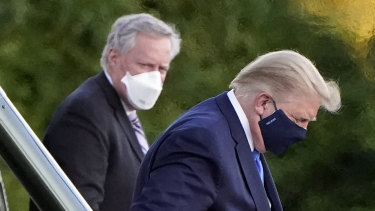Washington: Tens of millions of Americans awoke on Friday, local time, to discover that their president had tested positive for coronavirus. Donald Trump had revealed the startling news on Twitter just before 1am, when most Americans on the east coast were asleep.
What followed during the rest of the day was no more reassuring. The official line on Trump’s condition became increasingly dire, culminating in the news he would be taken to hospital in a helicopter.

The slow-drip of disturbing information – much of it revealed by the media rather than the White House – only increased the sense of distrust many Americans feel about the accuracy of what they hear from the Trump administration.
At first, it seemed as if Trump was doing remarkably well. White House chief-of-staff Mark Meadows fronted reporters in the morning to say that Trump was experiencing “mild” COVID symptoms, but was in “good spirits” and feeling “very energetic”.
“We’ve talked a number of times this morning,” Meadows said. “I got the five or six things that he tasked me to do, like I do every single morning. He is certainly wanting to make sure that we stay engaged.”
Kayleigh McEnany, the White House press secretary, painted a similarly rosy picture at lunchtime. “He’s been hard at work,” McEnany told reporters. “We’re having to slow him down a little bit.”
But something was missing: the President himself. The usually prolific tweeter had been completely silent, raising doubts about whether his illness was more serious than his advisers were letting on.
Was the White House’s priority providing Americans with accurate information, or trying to protect Trump from embarrassment?
Many thought that a televised statement must surely be coming any minute from Trump or White House physician Sean Conley. But it never did.
It was only at 4pm – 15 hours after Trump revealed his positive diagnosis – that Conley released a statement providing an update on Trump’s condition. The phrase “good spirits” was there again but so was a new, less comforting, word: Trump was “fatigued”.
Trump was also having trouble breathing, according to a White House source quoted by US media outlets.
Conley also revealed that he had administered Trump a dose of an experimental antibody cocktail made by the pharma company Regeneron.
Suddenly alarm bells started ringing. If the President’s symptoms really were only “mild”, why was his doctor administering this unproven medication. It was only through reporting from outlets such as The New York Times that Americans learnt that Trump was experiencing symptoms such as fever, nasal congestion and a cough.
Then the news starting leaking out: Trump was being transferred to the Walter Reed Medical Centre.
The Trump administration said the move was due to an “abundance of caution”. But the image of a military helicopter landing on the White House lawn to medivac the 74-year old President to a nearby hospital seemed to tell a different story.
So did a tweet from Trump’s son Eric describing his father as a “true warrior” and saying: “I have never been more proud of someone and what they have had to endure.”
An 18-second video message from Trump didn’t provide any clarity, either.
“I think I’m doing very well, but we’re going to make sure that things work out,” he said.
A day that began with shock ended with confusion.
